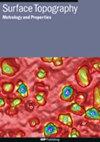金刚石车削正弦结构的精度,作为用于评估地形图真实性的测量标准
IF 2
3区 材料科学
Q2 ENGINEERING, MECHANICAL
引用次数: 0
摘要
在光学表面测量中,评估形貌测量信号的保真度至关重要。其中一个量化参数是 ISO 25 178-600:2019 中定义的小尺度保真度限值 TFIL。为确定该参数,需要生成正弦结构,其中波长根据离散啁啾系列进行调制。这些物体是通过超精密金刚石车削加工而成的。平面区域和斜率小于 4° 的区域的形状偏差≲10 nm。对切削刀具刀头半径的初步估计导致偏差,使结构的脊过窄,约 150 nm,而沟槽过宽。在窄沟槽的底部,可观察到高度约为 20 至 100 nm 的隆起形式的偏差。在欧洲 TracOptic 项目的循环测试中,本研究调查的测量标准也被用于鉴定光学仪器,该项目要求精确了解所有结构的几何形状。使用 Met.LR-AFM 测量仪测量了地形的几何形状、余弦结构与形状偏差的叠加。LR-AFM 计量长距离原子力显微镜进行测量。本文章由计算机程序翻译,如有差异,请以英文原文为准。
Precision of diamond turning sinusoidal structures as measurement standards used to assess topography fidelity
In optical surface metrology, it is crucial to assess the fidelity of the topography measuring signals. One parameter to quantify this is the small-scale fidelity limit T
FIL defined in ISO 25 178-600:2019. To determine this parameter, sinusoidal structures are generated, where the wavelengths are modulated according to a discrete chirp series. The objects are produced by means of ultra-precision diamond face turning. Planar areas and regions with slopes below 4° could be produced with form deviations of ≲10 nm. An initial estimate of the cutting tool’s nose radius resulted in a deviation that caused the ridges of the structures to be too narrow by approximately 150 nm, while the trenches were too wide. At the bottom of narrow trenches, deviations are observed in the form of elevations with heights of about 20 to 100 nm. The measurement standard investigated in this study has also been used to characterise optical instruments in a round-robin test within the European project TracOptic, which requires precise knowledge of the geometry of all structures. The geometry of the topography, cosine structures superimposed with form deviations, was measured using the Met. LR-AFM metrological long-range atomic force microscope of the German National Metrology Institute.
求助全文
通过发布文献求助,成功后即可免费获取论文全文。
去求助
来源期刊

Surface Topography: Metrology and Properties
Materials Science-Materials Chemistry
CiteScore
4.10
自引率
22.20%
发文量
183
期刊介绍:
An international forum for academics, industrialists and engineers to publish the latest research in surface topography measurement and characterisation, instrumentation development and the properties of surfaces.
 求助内容:
求助内容: 应助结果提醒方式:
应助结果提醒方式:


